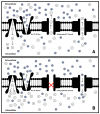The Silent Threat of Hypokalemia after High Voltage Electrical Injuries: A Case Study and Review of the Literature
- PMID: 38792394
- PMCID: PMC11122100
- DOI: 10.3390/jcm13102852
The Silent Threat of Hypokalemia after High Voltage Electrical Injuries: A Case Study and Review of the Literature
Abstract
High-voltage electrical injuries, especially from lightning strikes, can cause life-threatening complications due to extreme temperature and voltage exposure. While burns and cardiac complications have been widely described, the documentation of metabolic imbalances, particularly hypokalemia, has not been as prevalent. This report focuses on a patient with profound transient hypokalemia following a lightning strike, alongside a review of three similar cases of transient hypokalemia from the literature. Our patient, a previously healthy young man, was struck by lightning and subsequently suffered transient hypokalemia with lower extremity sensory changes, which resolved after the normalization of serum potassium levels. While the exact underlying mechanisms of transient hypokalemia following high-voltage electrical injuries are unknown, we propose a multifactorial mechanism, which includes massive intracellular shifts of potassium due to elevated epinephrine levels and the prevention of potassium efflux through the electrical disruption of voltage-gated potassium channels. Our report underscores the importance of recognizing hypokalemia in patients with high-voltage electrical injuries and contributes to the understanding of the complex mechanisms involved. Further research is necessary to understand the connection between cellular changes induced by high-voltage exposure and their effects on metabolism, particularly in relation to hypokalemia.
Keywords: electrical injuries; hypokalemia; lightning strikes; literature review; metabolic disturbances; potassium channels.
Conflict of interest statement
Ala Nozari served as a consultant for Third Pole Therapeutics and Takeda Pharmaceutical Company. No conflicts of interest are relevant to this report.
Figures



Similar articles
-
Severe hypokalemia as a cause of acute transient paraplegia following electrical shock.Burns. 2002 Sep;28(6):609-11. doi: 10.1016/s0305-4179(02)00063-3. Burns. 2002. PMID: 12220923
-
Lightning and thermal injuries.Handb Clin Neurol. 2014;120:981-6. doi: 10.1016/B978-0-7020-4087-0.00065-6. Handb Clin Neurol. 2014. PMID: 24365365 Review.
-
Lightning Strike.J Educ Teach Emerg Med. 2022 Jan 15;7(2):S78-S106. doi: 10.21980/J8SD2M. eCollection 2022 Apr. J Educ Teach Emerg Med. 2022. PMID: 37465437 Free PMC article.
-
Cutaneous Manifestations of Lightning Injury: A Review of the Literature.Skinmed. 2023 Aug 28;21(3):157-163. eCollection 2023. Skinmed. 2023. PMID: 37634096 Review.
-
[Lightning strikes and lightning injuries in prehospital emergency medicine. Relevance, results, and practical implications].Unfallchirurg. 2013 Jan;116(1):74-9. doi: 10.1007/s00113-011-2084-9. Unfallchirurg. 2013. PMID: 21909737 Review. German.
References
-
- Zemaitis M.R., Foris L.A., Lopez R.A., Huecker M.R. StatPearls, Treasure Island. StatPearls Publishing; Treasure Island, FL, USA: 2024. [(accessed on 29 March 2024)]. Electrical Injuries. Available online: http://www.ncbi.nlm.nih.gov/books/NBK448087/ - PubMed
-
- Lightning. [(accessed on 16 November 2023)]. Available online: https://www.public.asu.edu/~gbadams/lightning/lightning.html.
Publication types
LinkOut - more resources
Full Text Sources

